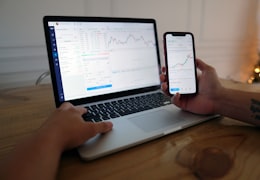How Low Will the Stock Market Go?

January was pretty fun for most investors. That joy extended into mid February as the S&P 500 made new highs.
Unfortunately, the breadth of stock gains was not very good. Plus, there were signs of increasing Risk Off activity. This moved out of the shadows into the light by the end of February causing us to test recent lows.
Today we will put a bright spotlight on this action to fully appreciate the extent of the market weakness...why it’s happening...and how to navigate these choppy waters to more prosperous shores.
Market Commentary
Let’s start with a look at the S&P 500 testing the technically important 200 day moving average on Tuesday for the first time in a long, long time.

(Yellow = 50 Day Moving Average / Orange = 100 Day MA / Red = 200 Day MA).
For as bad as that sounds...things are even worse.
Meaning that the -4.29% loss for the S&P 500 the past month is nothing compared to the more widespread pain in other areas.
Please take in this parade of charts to appreciate the greater weakness on display:
1 Month Performance by Market Cap

No surprise in large caps doing better than most. Mega Caps have been at the top of just about any performance chart going back 4 years because of the Magnificent 7. But in this case disruptions in AI have hurt members like NVDA. And gladly the obscene post-election rise for TSLA has been wiped away. All that added to Mega Caps not doing as well as per usual.
But in general, the smaller and riskier the stock...the greater the pain inflicted.
1 Month Performance for Weakest Industries

I wanted to show every industry down 10% or more. That’s because 10% is associated with a correction in a group and 20% is associated with a bear market in the group.
In general, the weakest groups are either those in the cross hairs of tariffs or economically sensitive industries which would be harmed by the increasing odds of recession (more on that vital topic further below).
Long story short, when you add up what these 2 charts are telling you, then you easily appreciate that the much more modest -4.29% loss for the S&P 500 does NOT tell the full story of the broad based pain that is taking place. This would more rightfully be called a correction. And perhaps the starting of the next bear market (not very likely...but possible).
This leads into the next vital question; WHY is this happening?
Growing uncertainties.
This theme has been at the heart of our recent Zen Investor commentaries including the special note on 1/13/25 followed by my comments in the February 2025 issue.
Let’s get you up to speed from there with something I wrote for another publication on 2/25/25:
“As you have no doubt heard many times in the past...The market HATES uncertainty!
Uncertainty = risk aversion = stocks head lower
Indeed, we have an interesting cocktail of elements leading to the current round of uncertainty. Let’s do a roll call:
Tariff Effects on the Economy: This is an ongoing saga where we have not seen the full extent of what the US is planning to do, nor the retaliatory tariffs from other nations. Note that the most recent Fed minutes talked about the likely inflationary nature of tariffs as yet another reason that they won’t be lowering the Fed funds rate any time soon.
Elevated Inflation: The most recent round of PPI, CPI and Average Hourly Earnings (aka wage inflation) shows inflation ticking higher after a long pause. That is the wrong direction and only exacerbates the aforementioned issue of when we get the next rate cut from the Fed. And yes, that becomes doubly worse if tariffs prove inflationary as many economists believe.
Consumer Question Marks: First came the warning of weakening demand from WalMarts recent earnings report. That got magnified Tuesday with much weaker than expected Consumer Confidence report (the lowest reading in 4 years).
Why is the consumer struggling even with strong employment? Sticky inflation + uncertainty over the effects of Trump administration policies. Remember that 49% of the nation did not want him in charge. And now their preferred news outlets are scaring them to death about the negative impacts of tariffs and DOGE = a potential tightening of purse strings that could weaken future GDP and corporate profit results.
I guess you could say “the consumer hates uncertainty too”.
DOGE (Department Of Government Efficiency): Most Americans agree that the government is too big and that it is unwise to run such large deficits. What they disagree on is WHERE the cuts should be made and HOW the cuts are enacted.
However, if you spend more in other places...or take in less in taxes because of cuts...then you are no closer to balanced budget nor helping ease the concerns of a future debt crisis (picture Greece debt crisis times 100). But the path to get there may very well lead to recession/depression which is what famed investor, and NY Mets owner Steve Cohen was saying last week.”
(End of 2/25/25 commentary)
Since that note the drum beat of tariffs has only grown louder and more confusing.
Even worse is that the famed GDPNow Model from the Atlanta Fed fell off a cliff after the Personal Income & Outlays report at the end of February. That is when the model flipped from +2.2% GDP growth prediction for Q1 all the way to negative -1.5%.
Next came the ISM Manufacturing report on 3/3 which pushed it down further to -2.8%.
NEVER in my life as an investment commentator have I seen this model turn so negative so fast.
This is not good. However, it doesn’t necessarily mean that a recession is on the way with new bear market on the prowl.
That same Personal Income & Outlays report from 2/28 showed that income is just fine. The problem is that spending is way down. I would say the main driver of that is the flurry of changes that have come from the Trump administration.
Remember that about half the population did not vote for him...a large % of those people are afraid of him...and their media outlet of choice is likely feeding them news that the world is falling apart with him at the helm.
This fear of what is happening now...and may happen in the future naturally causes people to be more cautious leading them to hold back on unnecessary purchases. That is how the economic picture changed so fast.
Worst case scenario is that it continues to devolve leading to recession and bear market.
Best case scenario...and most likely scenario...is that people get used to all the change. And start to realize that their worst fears are not coming true.
Since there job is still secure with new money flowing in, then they will soon spend that recent savings leading to healthy economic expansion.
The old adage is that the only things certain in this world are “death and taxes”.
Let me add a third element of certainty. The American consumer will spend every dollar in his wallet AND MORE.
Meaning all that extra savings being socked away will be spent at some point. Hopefully fairly soon as more people realize the sky is not falling. That should resolve the recent darkening of the economic outlook.
Let me add in that it was clear from Donald Trump’s first administration that he is very pro-business and pro-economy. And that he often used the growth of the stock market as a measuring stick of how much benefit he was providing to the economy.
Thus, it is my belief that higher tariffs are being used as a negotiating tool to get other countries to come to the table to find more reasonable accommodations to level the economic playing field. That may take another few months to come to fruition.
Plus there are plans to lower taxes for individuals and corporations that is most certainly stimulative.
Hard to be a bear when something as bullish as tax cuts are likely on the way.
Unfortunately, there is a possibility things continue to roll negative.
For example, Trump has talked about tariffs as a net positive and scoffed at it being inflationary that becomes a burdensome tax on the US consumer. If he doesn’t really understand how it is most certainly inflationary...then he may indeed enact policies with unintended consequences that could harm the economy. As in increase the odds of recession which most certainly is not good for stocks.
Again, I see that as the lower probability and not going to alter our investing strategy to prepare for such an event at this time.
Our game plan still calls for economic expansion and this bull market to roll on with new highs on the way by the end of the year...and higher highs for another 2-3 years thereafter. Just in the meantime the market will be volatile with downside bias.
The point is that my eyes are wide open to the possibility of things heading south and am prepared to make changes to our investment strategy if need be.
For now, we continue to have a diversified group of stocks that will excel when the market is Risk On again as it was in November and January. In the meantime, we know that volatility will wreak havoc on various groups and positions for no fault of their own. Patience is the key virtue to have us hold on to see them have appropriate and ample bounces.
The one modest adjustment in our strategy is the addition of the 3 more conservative stocks today which is a nod to the more volatile environment that could have more downside potential.
To sum it up, this is a precarious time with many moving parts that can change for the better or the worse. Again, my eyes are wide open to either possibility being true and prepared to do what is necessary to alter our investment plan.
Gladly with history as my guide we find that “time heals all wounds”.
In this case more time = more opportunity for people to understand policy changes and to see that their effects may not be as bad as advertised. And in fact, could be very positive (especially tax cuts).
The sooner that is understood...the sooner the consumer opens his wallet to spend once again...the sooner economic data becomes more positive...the sooner that stocks head north instead of south.
Until then continue to brace yourself for volatile market action as you have seen so far in 2025.
What To Do Next?
Discover the Zen Investor portfolio filled with my top stocks for the long haul.
And yes, each pick is harnessing the full power of the Zen Ratings model which has averaged a +32.52% annual return since 2003.
In total the Zen Investor portfolio has 17 stocks with tremendous long term potential.
That includes 3 stocks added in early March to stand up to recent market volatility and yet provide attractive upside.
If you are curious to learn more, and want to see my current top stocks, then please click the link below to get started now.
Discover the Zen Investor & Top Stocks >
Wishing you a world of investment success!

Steve Reitmeister…but everyone calls me Reity (pronounced “Righty”)
Editor of the Zen Investor
What to Do Next?
Want to get in touch? Email us at news@wallstreetzen.com.
Keep Reading
See All News




Company
AboutNewsBlogStock Investing FAQPlansPrivacy PolicyTerms of ServiceCancellation & RefundsPerformanceHelp GuidesContactTwitterYouTubeNewsletterInformation is provided 'as-is' and solely for informational purposes and is not advice. WallStreetZen does not bear any responsibility for any losses or damage that may occur as a result of reliance on this data.

